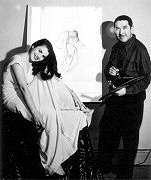

1896-1982
Vargas was painting in a store window in May 1919 when he was asked by a representative of the Ziegfeld Follies to show his work the next day to Mr Ziegfeld ... he was to become the most famous and prolific pin-up artist of all time.

Born 9 February 1896 in Peru, Alberto Vargas was the son of a renowned photographer, Max Vargas, who had taught him how to use an airbrush by the time he was thirteen. In 1911, while accompanying Max on a trip to Paris, Alberto came upon the famous magazine La Vie Parisienne, and its sensuous front covers by Raphael Kirchner made a lasting impression on him. He studied in Zurich and Geneva before leaving Europe because of the war and arriving on Ellis Island in October 1916.
Vargas' first encounter with America happened about noon at Broadway and Fourteenth Street, when he was suddenly surrounded by a lunchtime crowd of smartly dressed office workers. Mesmerized by their grace, sophistication, and beauty the young artist decided he would spend his life glorifying the American Girl.
Alberto Vargas' first job was drawing fashion illustrations (mostly in watercolour and pen and ink) for the Adelson Hat Company and Butterick Patterns. Eventually turning to freelance commercial illustration, he was painting in a store window in May 1919 when he was asked by a representative of the Ziegfeld Follies to show his work the next day to Mr Ziegfeld.
Within twenty-four hours, Vargas found himself commissioned to paint twelve watercolour portraits of the leading stars of the 1919 Ziegfeld Follies for the lobby of the New Amsterdam Theatre. Yet, although he was in the company of the most beautiful girls in the world, he knew there was only one woman for him: Anna Mae Clift, a showgirl with the rival Greenwich Village Follies. For the next twelve years, Vargas painted all the Ziegfeld stars, including names such as Billy Burke, Nita Naldi, Marilyn Miller, Paulette Goddard, Ruth Etting, Eddie Cantor, and W C Fields. He soon developed a friendship with Ziegfeld, who let the young artist call him "Ziggy", a name used only by the impresario's closest friends.
In 1927, Vargas went to work for the Paramount Pictures' art department in New York and was chosen to create the original artwork for the film Glorifying the American Girl, which was being produced by Ziegfeld. Working in an atmosphere of extraordinary harmony between artist, producer, and film, Vargas created advertising artwork that, aside from general distribution, also appeared in Paramount's 20th Anniversary Book, published in 1927 for the company's stars and executives.
Vargas maintained a full schedule throughout the 1920s, working for a diverse group of clients in addition to the Follies and Paramount. He painted front covers for Tatler and Dance magazines, did hairstyle illustrations for Harper's Bazaar, and even designed some countertop displays for Old Gold cigarettes. Yet he still found time to paint hisfavourite Ziegfeld Follies stars for his own pleasure, including the daring Shirley Vernon, whose 1927 portrait was preserved in his private collection.
All Pin-up Files gallery images are subject to copyright and must not be considered to be in the public domain. All copyright information is shown where known.